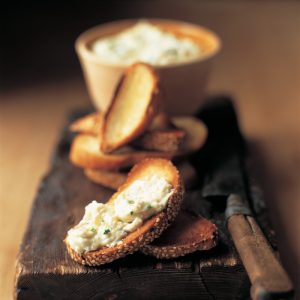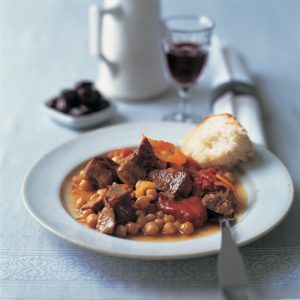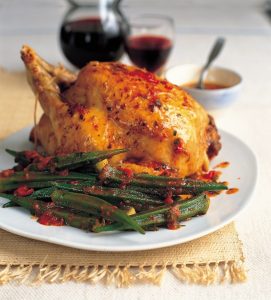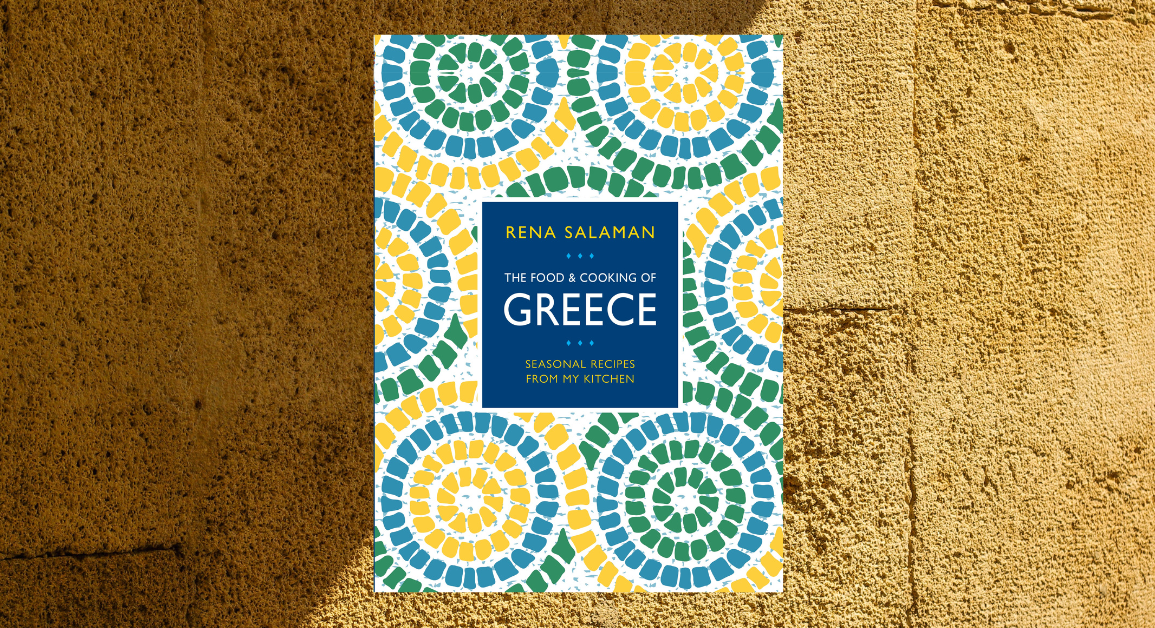The Food & Cooking of Greece – Did you manage a trip to Greece last summer? No, I didn’t either, but I do feel as if I’ve just had a sneaky trip there, as I’ve discovered a fabulous new cookbook and photographic celebration of the country: Rena Salaman – The Food & Cooking of Greece, Seasonal Recipes from my Kitchen. (£20 hardback from Lorenz Books) This glorious new book, an updated and expanded edition of her bestselling original, explores the dishes of Greece and the Islands through the changing seasons.

Greek food is a celebration of local foods and of culinary traditions that span generations. Greek cuisine centres around vegetables and other simple ingredients – olives and olive oil, sheep and goat cheeses, fish and lamb, and fruits both fresh and preserved. The new Greek wines are a revelation, and Rena explores and recommends the best.
Courgette fritters, salt cod bake and an Aegean cheese and honey tart in Spring; melitzanosalata and mousaka in Summer; baked feta parcels and chicken soup with avgolemono in Autumn; chickpea soup, roasted beetroot with garlic sauce, and spanakotyropitta in Winter. Roast Easter lamb, stuffed vine leaves, fried meatballs infused with mint, parsley, thyme and oregano… the classics are all here as well as lesser-known regional specialities.
Rena was born and grew up in Athens and spends every summer on the Aegean island of Alonnisos where she has a home. Her passion for Greek food and cooking shines through her highly regarded cookbooks. She writes for leading newspapers and magazines and appears on radio and television.
Here are a couple of recipes to take you and your tastebuds to Greece in this miserable weather!
Feta & roast pepper dip with chillies – Serves 4

“Htipiti is a familiar meze in the beautiful city of Thessaloniki. If you stop for an ouzo in the area called Lathathika, which used to be part of the old market but now teems with trendy bars and restaurants, you will inevitably be served a small plate of htipiti. The dip is almost unknown elsewhere in Greece. This recipe comes from my brother-in-law, Kostas Printzios, who hails from Thessaloniki.”
1 yellow or green elongated or bell-shaped pepper
1–2 fresh green chillies
200g/7oz feta cheese, cubed.
60ml/4 tbsp extra virgin olive oil
juice of 1 lemon
45–60ml/3–4 tbsp milk
ground black pepper
finely chopped fresh flat leaf parsley, to garnish
slices of toast or toasted pitta bread, to serve.
Scorch the pepper and chillies by threading them on to metal skewers and turning them over a flame or under the grill, until charred all over.
Set the pepper and chillies aside until cool enough to handle. Peel off as much of their skin as possible and wipe off the blackened parts with sheets of kitchen paper. Slit the pepper and chillies and discard the seeds and stems.
Put the pepper and chilli flesh into a food processor. Add the feta cheese, olive oil, lemon juice and milk, and blend well. Add a little more milk if the mixture is too stiff, and season with black pepper.
Spread the dip on slices of toast, sprinkle a little fresh parsley over the top and serve.
Variation: The dip is also excellent served with a selection of vegetable crudités, such as cauliflower florets or strips of carrot, celery or green or red bell pepper.
Pork with Chickpeas & Orange – Serves 4

“This winter speciality, revithia me hirino ke portokali, is a familiar dish in the Aegean islands, particularly in Crete. In the villages of Mesara, it is traditionally offered to family and close friends on the night before a wedding. This version comes from the island of Chios.”
350g/12oz dried chickpeas, soaked overnight in water to cover.
75–90ml/5–6 tbsp extra virgin olive oil
800g/1¾lb boneless leg of pork, cut into large cubes.
1 large onion, sliced
2 garlic cloves, chopped.
400g/14oz canned chopped tomatoes.
grated rind of 1 orange
1 small dried red chilli
salt and ground black pepper
bread and olives, to serve.
Drain the chickpeas, rinse them under cold water and drain them again.
Place them in a large, heavy pan. Pour in enough cold water to cover generously, put a lid on the pan and bring to the boil. Skim the surface, replace the lid and cook gently for 1–1½ hours, depending on the age and pedigree of the chickpeas. Alternatively, cook them in a pressure cooker for 20 minutes under full pressure. When the chickpeas are soft, drain them, reserving the cooking liquid, and set them aside.
Heat the oil in the clean pan and brown the meat cubes in batches. As each cube browns, lift it out with a slotted spoon and put it on a plate. When all the cubes have been browned, add the onion to the oil remaining in the pan and sauté for 10–15 minutes, until light golden.
Stir in the garlic, then as soon as it becomes aromatic, add the tomatoes and grated orange rind. Crumble in the chilli.
Add the chickpeas and meat to the pan, then pour in enough of the reserved chickpea cooking liquid to cover. Add the black pepper, but not salt at this stage.
Mix well, cover the pan and simmer for about 1 hour, or until the meat is tender. Stir occasionally and add more of the reserved liquid if needed. The result should be a moist casserole; not soupy, but not dry either. Season with salt before serving with bread and olives.
Roast chicken with okra – Serves 4


My English husband became so enamoured of this dish when he first ate it at my parents’ house in Athens in the early 1970s that from then on, my mother used to include it in her menu whenever we stayed with them. In Greece, okra is a summer staple. It is cooked on its own, or can be combined with lamb or beef, and tastes delicious in a chicken casserole, as in this dish, kotopoulo me bamies fournou.
1.6kg/3½lb chicken
90ml/6 tbsp extra virgin olive oil
5ml/1 tsp dried oregano
400g/14oz canned plum tomatoes, chopped
2 garlic cloves, chopped
450ml/¾ pint hot water
600g/1lb 6oz okra
salt and ground black pepper
45ml/3 tbsp chopped fresh flat-leaf parsley
salad and fresh crusty bread, to serve (optional)
Cook’s tip If you buy a larger chicken, or use large okra pods, you may need to increase the cooking time. The chicken will be cooked when the joints move freely and the juices that flow when the thickest part of the thigh is pierced with a knife are clear.
Preheat the oven to 200°C/400°F/Gas 6. Place the chicken breast-side down in a large roasting dish. Drizzle half the oil over it and sprinkle over half the oregano. Add the tomatoes, garlic and 300ml/½ pint of the hot water to the dish. Transfer to the oven and bake for 30 minutes.
Meanwhile, prepare the okra. Leave each okra pod whole and use a small sharp knife to peel the conical end. Be careful not to nick the pod and release the mucilaginous juices. Rinse the okra thoroughly in cold water and then drain them well. Repeat until the water runs clear.
After 30 minutes, remove the dish from the oven and turn the chicken over. Add the okra, spreading it evenly around the bird. Drizzle over the remaining oil, then sprinkle with the rest of the oregano. Season and add the parsley and the remaining hot water. Turn the okra with a spatula to coat it in the tomato sauce.
Reduce the oven temperature to 180°C/350°F/Gas 4 and cook the chicken for 1 hour more, or until it is fully cooked, and the okra is tender. Baste the chicken and the okra occasionally during cooking.
This dish is best served hot but will happily sit for 30 minutes. It makes the perfect main course accompanied by a salad and fresh crusty bread, if liked.
The Seasoned Gastronome


